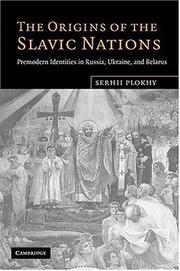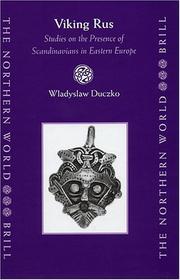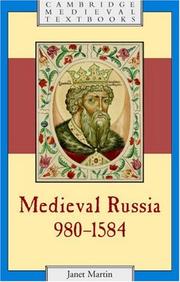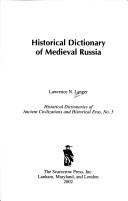| Listing 1 - 9 of 9 |
Sort by
|

ISBN: 9780521155113 0521864038 9780521864039 9780511496837 0511246358 9780511246357 9780511247040 0511247044 9786610703692 6610703698 0511244878 0511496834 0521155118 1107169232 1280703695 0511318847 0511245645 Year: 2006 Publisher: Cambridge, UK ; New York : Cambridge University Press,
Abstract | Keywords | Export | Availability | Bookmark
 Loading...
Loading...Choose an application
- Reference Manager
- EndNote
- RefWorks (Direct export to RefWorks)
This book documents developments in the countries of eastern Europe, including the rise of authoritarian tendencies in Russia and Belarus, as well as the victory of the democratic 'Orange Revolution' in Ukraine, and poses important questions about the origins of the East Slavic nations and the essential similarities or differences between their cultures. It traces the origins of the modern Russian, Ukrainian and Belarusian nations by focusing on pre-modern forms of group identity among the Eastern Slavs. It also challenges attempts to 'nationalize' the Rus' past on behalf of existing national projects, laying the groundwork for understanding of the pre-modern history of Russia, Ukraine and Belarus. The book covers the period from the Christianization of Kyivan Rus' in the tenth century to the reign of Peter I and his eighteenth-century successors, by which time the idea of nationalism had begun to influence the thinking of East Slavic elites.
Slavs, Eastern --- Ethnic identity. --- History. --- Origin. --- Religion. --- Europe, Eastern --- Slavic countries --- Kievan Rus --- East Slavs --- Eastern Slavs --- Kyivan Rus --- Drevni︠a︡i︠a︡ Rusʹ (Medieval state) --- Kieŭskai︠a︡ Rusʹ --- Kievskai︠a︡ Rusʹ (Medieval state) --- Kiev (Medieval state) --- Kyivan Rusʹ --- Kyïvsʹka Rusʹ --- Ruce --- Rusʹ --- Rus' Kieviana --- Древняя Русь --- Киевская Русь --- Київська Русь --- Русь --- Arts and Humanities --- History --- Slaves --- Russie --- Ukraine --- Histoire

ISBN: 9004138749 9786610915217 9047405439 1280915218 1429409967 9781429409964 9789004138742 Year: 2004 Volume: 12 Publisher: Leiden Brill
Abstract | Keywords | Export | Availability | Bookmark
 Loading...
Loading...Choose an application
- Reference Manager
- EndNote
- RefWorks (Direct export to RefWorks)
History of Scandinavia and Iceland --- History of Eastern Europe --- anno 500-1499 --- Kievan Rus --- History --- Kyivan Rus --- Drevni︠a︡i︠a︡ Rusʹ (Medieval state) --- Kieŭskai︠a︡ Rusʹ --- Kievskai︠a︡ Rusʹ (Medieval state) --- Kiev (Medieval state) --- Kyivan Rusʹ --- Kyïvsʹka Rusʹ --- Ruce --- Rusʹ --- Rus' Kieviana --- Древняя Русь --- Киевская Русь --- Київська Русь --- Русь --- History. --- Drevni︠a︡i︠a︡ Rusʹ --- Kievskai︠a︡ Rusʹ
Book
ISBN: 9004260226 9789004260221 9789004259829 9004259821 1306028019 Year: 2013 Publisher: Leiden, Netherlands : Koninklijke Brill NV,
Abstract | Keywords | Export | Availability | Bookmark
 Loading...
Loading...Choose an application
- Reference Manager
- EndNote
- RefWorks (Direct export to RefWorks)
In The Nature and the Image of Princely Power in Kievan Rus', 980-1054 , Walter K. Hanak offers a critical analysis of the annalistic, literary, and other works that provide rich if conflicting and contradictory information on the nature of princely power and their image or literary representations. The primary sources demonstrate an interaction between the reality and the notions concerning princely power and how this power generates an image of itself. The author also analyses the textual incongruities that appear to be a reflection of a number of currents -- Byzantine, Varangian, Khazar, and Eastern Slavic. The secondary sources provide a variety of interpretations, which Hanak seeks to uphold and dispute. His stress, however, is to view this evidence in the light of a newly Christianized state and the launching of a maturative process in its early history.
Princes --- Royalty --- Courts and courtiers --- Kievan Rus --- Ukraine --- Drevni︠a︡i︠a︡ Rusʹ (Medieval state) --- Kieŭskai︠a︡ Rusʹ --- Kievskai︠a︡ Rusʹ (Medieval state) --- Kiev (Medieval state) --- Kyivan Rusʹ --- Kyïvsʹka Rusʹ --- Ruce --- Rusʹ --- Rus' Kieviana --- Древняя Русь --- Киевская Русь --- Київська Русь --- Русь --- History --- Kings and rulers. --- Sources. --- Russie kiévienne --- Histoire --- Rois et souverains --- Sources --- Kyivan Rus --- Drevni︠a︡i︠a︡ Rusʹ --- Kievskai︠a︡ Rusʹ
Book
ISBN: 1641899506 1942401493 9781942401490 9781942401483 1942401485 Year: 2018 Publisher: Leeds
Abstract | Keywords | Export | Availability | Bookmark
 Loading...
Loading...Choose an application
- Reference Manager
- EndNote
- RefWorks (Direct export to RefWorks)
This book intertwines two themes in medieval studies hitherto kept apart: comparisons of Latin and Orthodox Europe and the 'feudal revolution' of the late- and post-Carolingian periods. The book broadens the debate by comparing texts written in 'learned' and 'vulgar' Latin, Church Slavonic, Anglo-Norman, and East Slavonic. From this comparison, the Kingdom of the Rus appears as a regional variation of European society. This suggests current interpretations overemphasize factors unique to the medieval West and overlook deeper pan-European processes.
Property. --- Power (Social sciences) --- Feudalism. --- Property --- Feudalism --- Feudal tenure --- Civilization, Medieval --- Land tenure --- Land use --- Land use, Rural --- Chivalry --- Estates (Social orders) --- Empowerment (Social sciences) --- Political power --- Exchange theory (Sociology) --- Political science --- Social sciences --- Sociology --- Consensus (Social sciences) --- Economics --- Possession (Law) --- Things (Law) --- Wealth --- History. --- Law and legislation --- Europe --- Europe. --- Council of Europe countries --- Eastern Hemisphere --- Eurasia --- Drevni͡ai͡a Rusʹ --- Kieŭskai͡a Rusʹ --- Kiev --- Kievskai͡a Rusʹ --- Kyïvsʹka Rusʹ --- Ruce --- Rusʹ --- Rus' Kieviana --- Kievan Rus --- History --- Ukraine --- Primitive property
Book
ISBN: 0674065468 0674068548 9780674068544 9780674065468 9780674063846 0674063848 Year: 2012 Publisher: Cambridge, Massachusetts
Abstract | Keywords | Export | Availability | Bookmark
 Loading...
Loading...Choose an application
- Reference Manager
- EndNote
- RefWorks (Direct export to RefWorks)
An overriding assumption has long directed scholarship in both European and Slavic history: that Kievan Rus' in the tenth through twelfth centuries was part of a Byzantine commonwealth separate from Europe. Christian Raffensperger refutes this conception and offers a new frame for two hundred years of history, one in which Rus' is understood as part of medieval Europe and East is not so neatly divided from West.With the aid of Latin sources, the author brings to light the considerable political, religious, marital, and economic ties among European kingdoms, including Rus', restoring a historical record rendered blank by Rusianmonastic chroniclers as well as modern scholars ideologically motivated to build barriers between East and West. Further, Raffensperger revises the concept of a Byzantine Commonwealth that stood in opposition to Europe-and under which Rus' was subsumed-toward that of a Byzantine Ideal esteemed and emulated by all the states of Europe. In this new context, appropriation of Byzantine customs, law, coinage, art, and architecture in both Rus' and Europe can be understood as an attempt to gain legitimacy and prestige by association with the surviving remnant of the Roman Empire. Reimagining Europe initiates an expansion of history that is sure to challenge ideas of Russian exceptionalism and influence the course of European medieval studies.
Christianity --- Religions --- Church history --- Europe --- Kievan Rus --- Ukraine --- Council of Europe countries --- Eastern Hemisphere --- Eurasia --- Byzantine Empire --- Drevni︠a︡i︠a︡ Rusʹ (Medieval state) --- Kieŭskai︠a︡ Rusʹ --- Kievskai︠a︡ Rusʹ (Medieval state) --- Kiev (Medieval state) --- Kyivan Rusʹ --- Kyïvsʹka Rusʹ --- Ruce --- Rusʹ --- Rus' Kieviana --- Древняя Русь --- Киевская Русь --- Київська Русь --- Русь --- Relations --- Civilization --- Byzantine influences. --- History --- Kyivan Rus --- Drevni︠a︡i︠a︡ Rusʹ --- Kievskai︠a︡ Rusʹ

ISBN: 9780521676366 9780521859165 0521676363 0521859166 9780511811074 9780511370052 0511370059 9780511649431 0511649436 0511811071 9780511369537 1107177480 0511369530 0511568843 Year: 2007 Publisher: Cambridge Cambridge University Press
Abstract | Keywords | Export | Availability | Bookmark
 Loading...
Loading...Choose an application
- Reference Manager
- EndNote
- RefWorks (Direct export to RefWorks)
This revised edition is a concise, yet comprehensive narrative of the history of Russia from the reign of Vladimir I the Saint, through to the reign of Ivan IV the Terrible. Supplementing the original edition with results of recently published scholarship as well as her own research, Janet Martin emphasizes the dynamics of Russia's political evolution from the loose federation of principalities known as Kievan Rus' through the era of Mongol domination to the development of the Muscovite state. Her analyses of the ruling dynasty, of economic influences on political development, and her explorations of society, foreign relations, religion, and culture provide a basis for understanding the transformations of the lands of Rus'. Her lines of argument are clear and coherent; her conclusions and interpretations are provocative. The result is an informative, accessible, up-to-date account that will be of interest to both students and specialists of early Rus'.
Kievan Rus --- Russia --- History --- Russie kiévienne --- Russie kiévienne --- History. --- Russie --- Histoire --- Rossīi︠a︡ --- Rossīĭskai︠a︡ Imperīi︠a︡ --- Russia (Provisional government, 1917) --- Russia (Vremennoe pravitelʹstvo, 1917) --- Russland --- Ṛusastan --- Russia (Tymchasovyĭ uri︠a︡d, 1917) --- Russian Empire --- Rosja --- Russian S.F.S.R. --- Russia (Territory under White armies, 1918-1920) --- Soviet Union --- Kyivan Rus --- Drevni︠a︡i︠a︡ Rusʹ (Medieval state) --- Kieŭskai︠a︡ Rusʹ --- Kievskai︠a︡ Rusʹ (Medieval state) --- Kiev (Medieval state) --- Kyivan Rusʹ --- Kyïvsʹka Rusʹ --- Ruce --- Rusʹ --- Rus' Kieviana --- Древняя Русь --- Киевская Русь --- Київська Русь --- Русь --- Arts and Humanities --- Kievan Rus - History --- Russia - History - To 1533 --- Russia - History - Ivan IV, 1533-1584
Book
ISBN: 077342959X 9780773429598 9780773438491 0773438491 Year: 2009 Publisher: Lewiston Edwin Mellen Press
Abstract | Keywords | Export | Availability | Bookmark
 Loading...
Loading...Choose an application
- Reference Manager
- EndNote
- RefWorks (Direct export to RefWorks)
Although new histories of Russia, often reflecting the author's cultural slant, appear regularly, there is a dearth of books that explain the Russian perspective. This work takes the opposite approach by acquainting readers with some of the foremost ideas in Russian cultural history. This book contains twelve color photographs and sixteen black and white photographs.
Kievan Rus -- Civilization. --- Kievan Rus -- Intellectual life. --- Russia -- Civilization. --- Russia -- Intellectual life. --- Russia (Federation) -- Civilization. --- Russia (Federation) -- Intellectual life. --- Russian literature -- History and criticism. --- Soviet Union -- Civilization. --- Soviet Union -- Intellectual life. --- Russian literature --- Regions & Countries - Europe --- History & Archaeology --- Russia & Former Soviet Republics --- History and criticism --- Kievan Rus --- Russia --- Soviet Union --- Russia (Federation) --- Intellectual life. --- Civilization. --- Drevni︠a︡i︠a︡ Rusʹ (Medieval state) --- Kieŭskai︠a︡ Rusʹ --- Kievskai︠a︡ Rusʹ (Medieval state) --- Kiev (Medieval state) --- Kyivan Rusʹ --- Kyïvsʹka Rusʹ --- Ruce --- Rusʹ --- Rus' Kieviana --- Древняя Русь --- Киевская Русь --- Київська Русь --- Русь --- Intellectual life --- Kyivan Rus' --- Drevni︠a︡i︠a︡ Rusʹ --- Kievskai︠a︡ Rusʹ

ISBN: 1282520873 9786612520877 0810866188 9780810866188 0810840804 9780810840805 9781282520875 6612520876 Year: 2002 Publisher: Lanham, Md. Scarecrow Press
Abstract | Keywords | Export | Availability | Bookmark
 Loading...
Loading...Choose an application
- Reference Manager
- EndNote
- RefWorks (Direct export to RefWorks)
The dictionary covers the history of Russia from its founding in the mid-ninth century to the reign of Peter the Great. It contains entries on politics, society, economy, literature, religion, art.
Kievan Rus --- Russia --- Russie --- Rossīi︠a︡ --- Rossīĭskai︠a︡ Imperīi︠a︡ --- Russia (Provisional government, 1917) --- Russia (Vremennoe pravitelʹstvo, 1917) --- Russland --- Ṛusastan --- Russia (Tymchasovyĭ uri︠a︡d, 1917) --- Russian Empire --- Rosja --- Russian S.F.S.R. --- Russia (Territory under White armies, 1918-1920) --- Drevni︠a︡i︠a︡ Rusʹ (Medieval state) --- Kieŭskai︠a︡ Rusʹ --- Kievskai︠a︡ Rusʹ (Medieval state) --- Kiev (Medieval state) --- Kyivan Rusʹ --- Kyïvsʹka Rusʹ --- Ruce --- Rusʹ --- Rus' Kieviana --- Древняя Русь --- Киевская Русь --- Київська Русь --- Русь --- History --- Dictionaries --- English --- To 1533 --- 1533-1613 --- 1613-1689 --- Drevni︠a︡i︠a︡ Rusʹ --- Kievskai︠a︡ Rusʹ
Book
ISBN: 1641899050 1942401329 1942401310 Year: 2017 Publisher: Bradford : Arc Humanities Press,
Abstract | Keywords | Export | Availability | Bookmark
 Loading...
Loading...Choose an application
- Reference Manager
- EndNote
- RefWorks (Direct export to RefWorks)
As scholarship continues to expand the idea of medieval Europe beyond 'the West,' the Rus' remain the final frontier relegated to the European periphery. The Kingdom of Rus' challenges the perception of Rus' as an eastern 'other' - advancing the idea of the Rus' as a kingdom deeply integrated with medieval Europe, through an innovative analysis of medieval titles. Examining a wide range of medieval sources, this book exposes the common practice in scholarship of referring to Russian rulers as princes as a relic of early modern attempts to diminish the Rus'. Not only was Rus' part and parcel of medieval Europe, but in the eleventh and twelfth centuries Rus' was the largest kingdom in Christendom.
Nobility --- Noble class --- Noble families --- Nobles (Social class) --- Peerage --- Upper class --- Aristocracy (Social class) --- Titles of honor and nobility --- Kievan Rus --- Europe --- Drevni︠a︡i︠a︡ Rusʹ (Medieval state) --- Kieŭskai︠a︡ Rusʹ --- Kievskai︠a︡ Rusʹ (Medieval state) --- Kiev (Medieval state) --- Kyivan Rusʹ --- Kyïvsʹka Rusʹ --- Ruce --- Rusʹ --- Rus' Kieviana --- Древняя Русь --- Киевская Русь --- Київська Русь --- Русь --- Council of Europe countries --- Eastern Hemisphere --- Eurasia --- Kings and rulers --- History. --- Relations --- Kiev. --- Kingship. --- Medieval Europe. --- Rus'. --- Russia. --- Kyivan Rus --- Drevni︠a︡i︠a︡ Rusʹ --- Kievskai︠a︡ Rusʹ
| Listing 1 - 9 of 9 |
Sort by
|

 Search
Search Feedback
Feedback About UniCat
About UniCat  Help
Help News
News